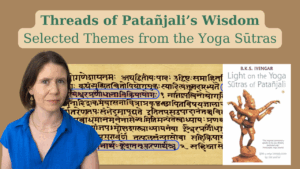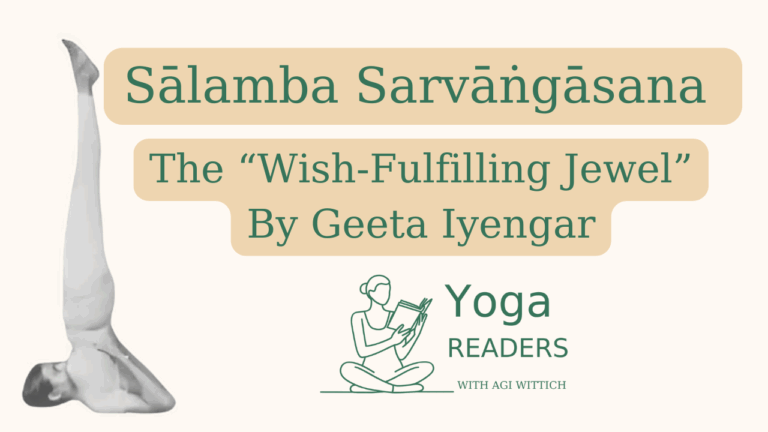
Threads of Patanjali’s Wisdom – Online Course
A course of selected themes from the Yoga Sutras with Dr. Agi Wittich The Yoga Sūtras of Patañjali are the philosophical heart of yoga.

Understanding Geeta Iyengar’s Profound Vision of the Shoulderstand
When most yoga practitioners think of Salamba Sarvāṅgāsana (सलम्ब सर्वाङ्गासन – supported shoulderstand pose), they might consider its physical benefits—improved circulation, thyroid stimulation, or spinal alignment. But Geeta Iyengar, daughter of B.K.S. Iyengar and a master teacher in her own right, saw something far more profound in this foundational pose. In her groundbreaking work “Yoga: A Gem for Women,” she refers to Sarvāṅgāsana using a Sanskrit term that might initially puzzle modern practitioners: Trilokya Chintāmaṇi.
What Does Trilokya Chintāmaṇi Actually Mean?
To understand Geeta’s vision, we must first decode this rich Sanskrit compound. Trilokya (त्रैलोक्य – the three worlds) refers to the three worlds of Hindu cosmology—the earthly realm (Bhūloka – physical world), the heavenly realm (Svarga – celestial realm), and the netherworld (Pātāla – underworld). Together, these represent the entire cosmic structure. Chintāmaṇi (चिन्तामणि – wish-fulfilling jewel) describes a mythical gem, comparable to the philosopher’s stone, capable of granting all desires and bringing total transformation.
But why would Geeta choose such an exalted term for what many consider a preparatory or restorative pose?
The “Queen of Āsanas” Deserves Royal Treatment
In “Yoga: A Gem for Women,” Geeta Iyengar makes a remarkable statement about the hierarchical relationship between yoga’s most revered poses. She explains that “If Śīrṣāsana (शीर्षासन – headstand) is King, Sarvāṅgāsana is the Queen of all the āsanas (आसन – seated postures/poses). Where Śīrṣāsana develops the manly qualities of will-power, sharpness of the brain and clarity of thought, Sarvāṅgāsana develops the feminine qualities of patience and emotional stability. It is considered to be the mother of āsanas.”
This is not merely poetic language—it reflects a sophisticated understanding of how different practices affect our entire being. While headstand (the “king”) cultivates sharp, penetrating awareness, shoulderstand (the “queen”) nurtures receptivity, patience, and emotional equilibrium.
To deepen this Queen–King analogy, explore how Śīrṣāsana complements Sarvāṅgāsana in “The Royal Inversions: Understanding Sarvāṅgāsana and Śīrṣāsana”.
Geeta’s choice of Trilokya Chintāmaṇi becomes clear when we examine what Sarvāṅgāsana actually accomplishes. Like the mythical wish-fulfilling jewel that grants desires across all three worlds, this pose works simultaneously on multiple dimensions of our existence:
Physical World (Bhūloka): The text describes how “Due to the inverted position, venous blood is taken to the heart for purification without any strain because of the force of gravity. Oxygenated blood is circulated to the chest area, relieving breathlessness, asthma (अस्थ्म – breathing disorder), bronchitis, throat ailments, and palpitation.”
Mental/Emotional World (Svarga): The practice “is very soothing to the nervous system and therefore good to practise when one is tensed, upset, irritated, fatigued, or when suffering from nervous breakdown and insomnia.”
For a deeper dive into how these inversions anchor one’s physical and emotional wellbeing, read “The Power of Standing Poses in Trauma‑Informed Iyengar Yoga”, where standing poses lay the groundwork for safe inversions.
Energetic/Spiritual World (Pātāla): Through the firm Jālandhara Bandha (जालन्धर बन्ध – throat lock/chin lock) created in the pose, “the thyroid and the parathyroid glands get ample supply of blood, thereby increasing their efficiency in maintaining the body and the brain in good balance.”
The Mother of All Healing
Perhaps most significantly, Geeta emphasizes Sarvāṅgāsana’s role as a healing force that transcends ordinary medical intervention. She writes that “As a mother struggles throughout her life for the happiness of her children, the ‘mother of āsanas‘ strives for peace and health of the body. It is no exaggeration to call this posture ‘Trailokya Chintāmaṇi‘ ‘a rare gem among the three worlds’.”
This maternal metaphor is crucial. Just as a mother’s care addresses every aspect of a child’s wellbeing—physical, emotional, and spiritual—Sarvāṅgāsana provides comprehensive nourishment across all dimensions of our existence.
The Practical Wisdom of the Three-World Jewel
For women particularly, Geeta notes that the pose “corrects urinary disorders, uterine displacement, and menstrual disorders” while simultaneously offering “peace, strength, and vigour (वीर्य – vital energy) to the practitioner and is recommended as the best recuperative treatment after long illness.”
This dual action—addressing specific female health concerns while providing overall vitality—exemplifies the “wish-fulfilling” quality of Trilokya Chintāmaṇi. The pose doesn’t just treat symptoms; it addresses root causes across multiple systems.
Learn more about how Iyengar yoga supports women through menstrual and reproductive challenges in the post “Ayurveda & Iyengar Yoga for Women”, where these practices are woven into seasonal wisdom and physiology.
Beyond Physical Benefits: A Gateway to Balance
What makes Sarvāṅgāsana truly deserving of the title Trilokya Chintāmaṇi is its capacity to create what Geeta calls emotional stability and patience—qualities essential for navigating life’s challenges. The pose teaches us to find stillness within inversion, to breathe calmly when our usual orientation is disrupted, and to trust in the wisdom of surrender.
The text emphasizes that “to avoid prolonged illness and to maintain robust health, practise Sarvāṅgāsana.” This isn’t merely about physical fitness—it’s about cultivating the inner resources necessary for resilience across all areas of life.
A Daily Practice of Transformation
When Geeta Iyengar calls Sarvāṅgāsana the Trilokya Chintāmaṇi, she invites us to approach this pose not as mere exercise, but as a daily opportunity for comprehensive transformation. Like the mythical wish-fulfilling jewel, regular practice of this āsana can grant us what we most deeply need: physical health, emotional stability, and spiritual clarity.
In a world that often fragments our attention across competing demands, Sarvāṅgāsana offers integration—a chance to experience ourselves as unified beings capable of healing and growth across all dimensions of existence.
If you’re curious about cultivating steady emotional resilience through Iyengar philosophy and choice-making, check out “Empowerment Through Choice”, where we explore how alignment and agency intersect in practice.
Reflective Questions for Your Practice
As you consider Geeta Iyengar’s profound understanding of Sarvāṅgāsana as Trilokya Chintāmaṇi, ask yourself:
If this post nourished your understanding, you’re welcome to Buy Me a Chai as a beautiful gesture of support.
And if you’d like to discuss your own inner questions or practice exploration, you can Talk Yoga with Agi and book a personal conversation.

A course of selected themes from the Yoga Sutras with Dr. Agi Wittich The Yoga Sūtras of Patañjali are the philosophical heart of yoga.

In a recent Yoga Readers session, Dr. Lois Steinberg opened her teaching archives and personal memories, sharing stories that span four decades of study

In the vast and intricate repertoire of yoga āsanas (postures), Śavāsana (Corpse Pose) holds a unique and profoundly significant position. Often superficially perceived as
Agi Wittich is a yoga practitioner since two decades, and is a certified Iyengar Yoga teacher. Wittich studied Sanskrit and Tamil at the Hebrew University of Jerusalem, Israel, completing a PhD with a focus on Hinduism, Yoga, and Gender. She has published academic papers exploring topics such as Iyengar yoga and women, the effects of Western media on the image of yoga, and an analysis of the Thirumanthiram yoga text.